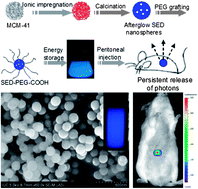In order to prepare new promising optical nanoprobes, long afterglow nanospheres with a narrow size distribution were successfully synthesized using mesoporous silica nanospheres (MSNs) both as morphology-controlling templates and the silicon source of long afterglow silicate. In our experiments, metal ions (Sr2+, Mg2+, Eu3+, Dy3+) were impregnated into the pores of mesoporous silica nanospheres followed by high temperature calcination. The X-ray powder diffraction results show that SrMgSi2O6 crystalline phase can be formed after calcination at 900 °C for 3 h in a weakly reducing atmosphere and the as-prepared afterglow nanospheres have a nominal composition of SiO2/SrMgSi2O6:Eu0.01, Dy0.02. The field emission scanning electron microscopy results indicate that the as-prepared long afterglow silicate nanoparticles have spherical morphology with a narrow size distribution and their size can be tuned between 50 nm and 500 nm. Approximately 10 nm pores can be formed in the as-prepared nanospheres, certified by the transmission electron microscopy and BET analysis results. Long afterglow properties, ranging from 400 nm to 550 nm, peaking at 467 nm, can be observed from the as-prepared nanospheres. After the surface was modified with amino groups, grafted by PEG–COOH and irradiated with 365 nm UV light for 10 min, the afterglow signal could be observed in real time for more than 1 h in a live mouse after peritoneal injection.

You have access to this article
 Please wait while we load your content...
Something went wrong. Try again?
Please wait while we load your content...
Something went wrong. Try again?


 Please wait while we load your content...
Please wait while we load your content...